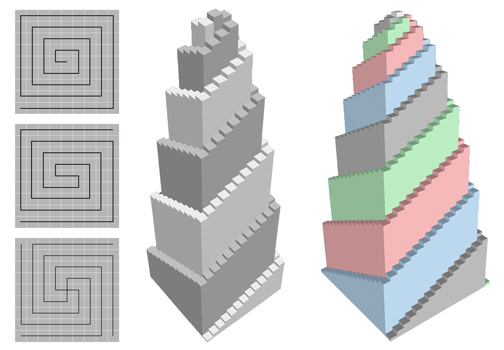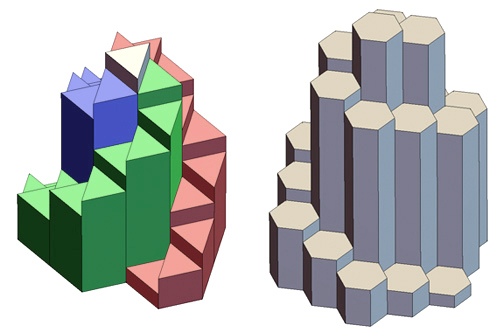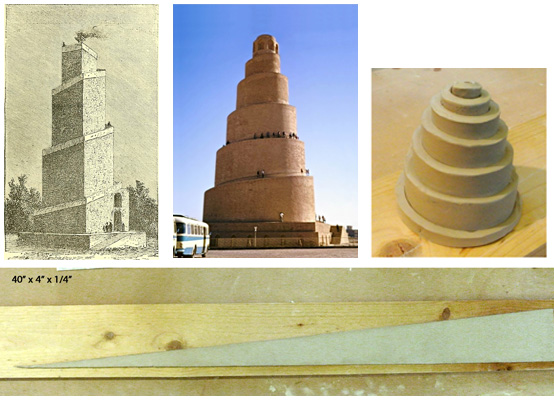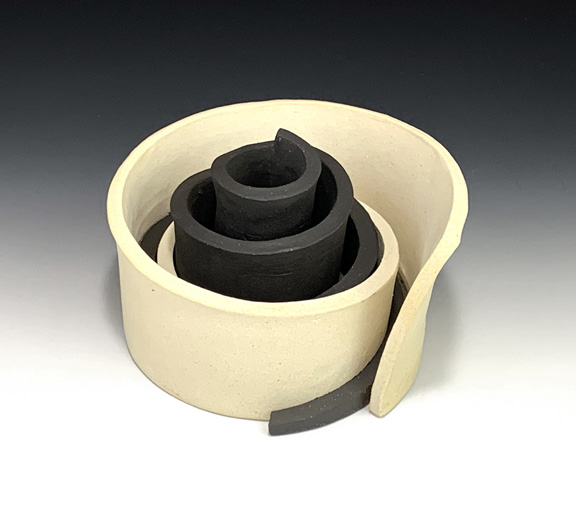Walkable Spiral Helices
Spiral Helices based on the regular tessellations
One simple way to connect tessellated squares is with a spiral. In addition to single spirals, double and quadruple spirals are possible. A helix is a 3D corkscrew, like a single strand of DNA. Combining spirals and helices creates towers, spiral helices, by forming steps from the individual squares (in the case of a spiral constructed from squares).

The structure below consists of two double spirals, each of which climbs continuously from one corner to the opposite corner. The two high points are joined.
The left tower below is based on a three-armed spiral of equilateral triangles. An equiateral-triangle-based tower could also take the form of a one-armed spiral. The right tower is based on a one-armed spiral of hexagons. Two-armed, three-armed, and six-armed spirals could also be used.

Circular Spiral Helices
The Tower of Gor, in modern-day Iran, is based on a square spiral helix. A 19th-century drawing is shown at left below; the building is now a ruin. The minaret of the Great Mosque of Samarra, at center below, in modern-day Iraq, is a ninth-century structure based on a cicular spiral helix (photograph by Vlastni Photo). Note that the vertical spacing between successive wrappings of the spiral are relatively uniform in this building.
With the sort of uniform ramp/staircase slope normally used in buildings, the spacing decreases as the peak is approached. This is due to the fact that the amount of material needed to complete a full revolution gets smaller as the peak (center) is approached. Clay offers a convenient medium to create a similar structure to the minaret. An elongated right triangle of clay with uniform thickness was rolled to form the spiral helix at right below (clay ramp shown beneath it), where the hypotenuse of the triangle provided the constant slope. The spacing of the wrappings is seen to decrease as the peak is approached. In order to achieve more uniform spacing, the slope of the ramp would need to increase as the peak is approached.

As a further experiment with this sort of form using clay, two long linear ramps formed with two different types of clay were placed small end to large end and rolled up to form the sculpture below, shown after firing.

All images copyright Robert Fathauer
Robert Fathauer's Fractal Diversions home
Fractal Tiling
 Fractal Knots
Fractal Knots
 Gasket Fractals
Gasket Fractals
 Fractal Trees
Fractal Trees
 Hyperbolic & Folded Fractals
Hyperbolic & Folded Fractals
 Polyhedra
Polyhedra
 Papers etc.
Papers etc.